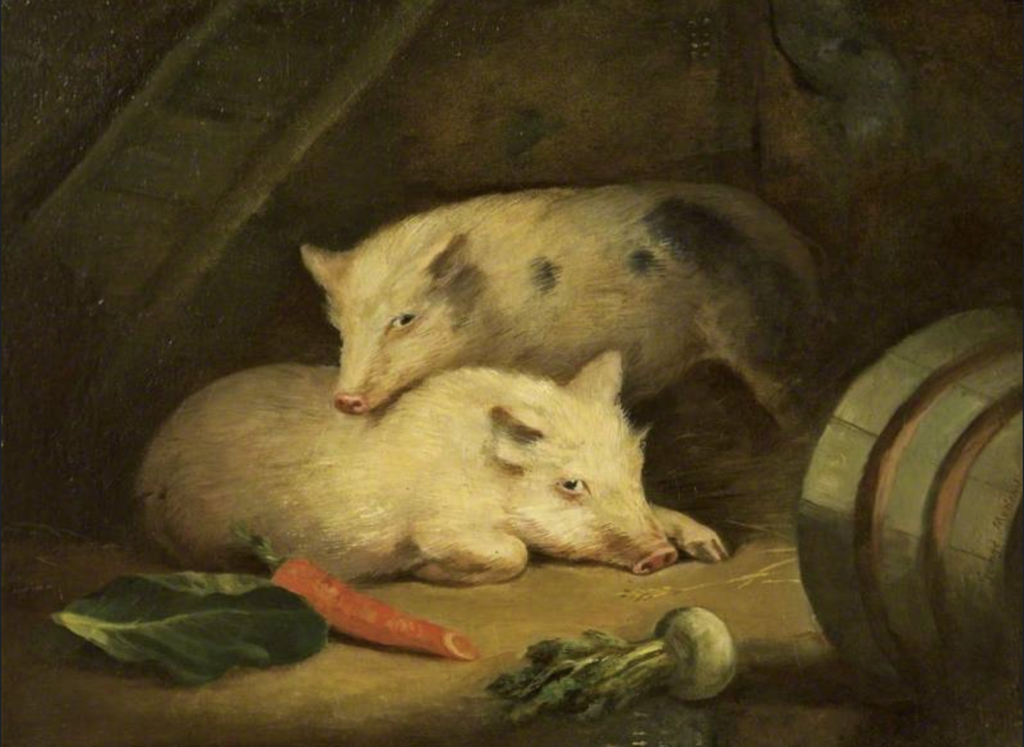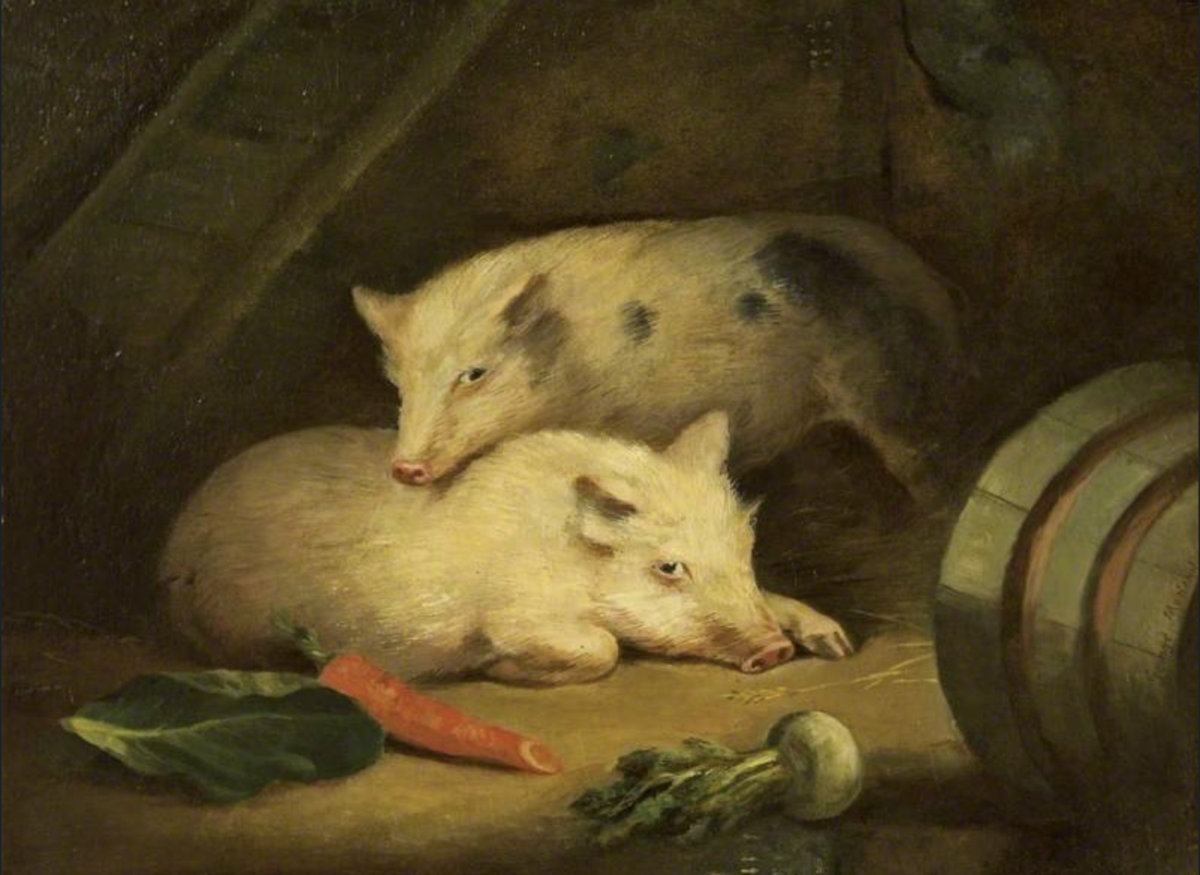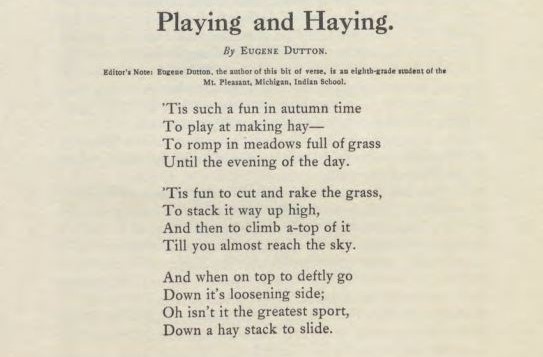The Unruly Pigs
By Hellen Rebecca Anderson (Cherokee), age 8
Annotations by Karen L. Kilcup

Billy Wiggs once caught some pigs, [1] And he put them in a pen, But the pen was not strong, And so all went wrong, And the pigs were gone again. He followed them fast, And found them at last And put them in another; They ate and they fussed, As if they would bust, And he sold them to his mother.
HELLEN REBECCA Anderson, “The Unruly Pigs,” Twin territories 5, no. 4 (April 1903): 136.
[1] Wiggs may be a Chickasaw name. In the late 1890s, a Richard C. Wiggs applied for tribal enrollment on the Dawes Rolls. His application is listed in the National Archives catalog. See below.
Contexts
Anderson was featured in Twin Territories, an Indian Territories magazine that achieved national recognition. The lavishly illustrated periodical was edited and published by Ora V. Eddleman (later Reed) beginning in 1899, when the editor was herself only nineteen years old. “The Unruly Pigs” appeared in a new column that Eddleman inaugurated, “For the Little Chiefs and Their Sisters”; Anderson’s poem had the honor of being the first contribution by a young reader. Eddleman was responding to a letter from “a little Indian girl—a bright little Cherokee maid” who wrote to the magazine with a request: “Twin Territories is good, and of course we all read it, and look at the pictures. Once my papa’s picture was in it, and we all liked it. But I think if you would have a page for the children’s own it would be better. We want a page that we can write for and can have pictures in it. Won’t you please fix a page for us?”
Eddleman responds with encouragement, aiming to make the new feature “attractive” and announcing plans for “prizes for the best stories, poems, compositions, etc.” She comments, “Especially do we urge the Indian children to contribute.” Eddleman prefaces “The Unruly Pigs” proudly: “The following poem was written by a little Cherokee girl just eight years of age—Hellen Rebecca Anderson, daughter of Mrs. Mabel Washbourne Anderson, a contributor to Twin Territories. The poem is entirely original with little Hellen, and we give it just as she submitted the manuscript to Twin Territories.”
The magazine’s goal was to showcase the achievements of Native peoples in the area that would become Oklahoma and to combat the stereotype of Indians as uncivilized.
Resources for Further Study
- Carpenter, Cari, and Karen L. Kilcup. Introduction. Selected Writing of Ora Eddleman Reed, Cherokee Author, Editor, and Activist. Lincoln: University of Nebraska Press, forthcoming.
- Constantin, Dave. “Rewriting History—for the Better.” Teaching Tolerance 51 (Fall 2015).
- Kilcup, Karen L. “Mabel Washbourne Anderson (Cherokee, 1863-1949).” In Native American Women’s Writing, c. 1800-1924: An Anthology. Malden, MA and Oxford, UK: Blackwell, 2000. 248-49.
- Pennington, William D. “Twin Territories.” Oklahoma Historical Society.
- Wilson, Linda D. “Reed, Ora V. Eddleman (1880-1968).” Oklahoma Historical Society.
- ———. “Twin Territories: The Indian Magazine.” Oklahoma Historical Society.
Pedagogy
Numerous resources support teaching at various levels about Native Americans in the Twin Territories, Oklahoma, and the United States more generally. The Cherokees were long invested in fostering their citizens’ education, and teachers can help students learn about the Cherokee Female Seminary and the Cherokee Male Seminary. A few examples follow, but many more are easily found on the web.
Boatman, Christine. “Lessons Learned in Teaching Native American History.” Edutopia. George Lucas Educational Foundation, September 18, 2019. “A white teacher shares resources and things she’s learned: Be humble, find the gaps in your knowledge, and listen to Native voices.”
“Maps and Spatial Data: Map Resources for Teaching Oklahoma History.” Edmon Low Library. Oklahoma State University. Includes maps of Indian Territory from 1889 and of the proposed State of Sequoyah from 1905.
“Teacher’s Guide. American Indian History and Heritage.” EDSITEment! National Endowment for the Humanities.
“Transforming teaching and learning about Native Americans.” Native Knowledge 360° Education Initiative. National Museum of the American Indian, Smithsonian. The site offers educators and others free webinars, including many hosted by Native Americans, aimed to correct problematic narratives about Native Americans; it maintains an archive of previous sessions.
Contemporary Connections
One ongoing manifestation of the Cherokees’ commitment to education is their newspaper, the Cherokee Phoenix. A version of this newspaper, edited by Cherokee Elias Boudinot, first appeared in 1829 as the Cherokee Phoenix, and Indians’ Advocate. The weekly newspaper, which appeared in both English and the Cherokee syllabary developed by Chief Sequoyah, contained a wide range of materials, including the Cherokee Constitution, political and religious news, biographies of notable Cherokees, and more. In “Education has always been important to the Cherokees” (March 12, 2004), Principal Chief Chad Smith celebrates the nation’s tradition, commenting that “before statehood, our school system was the envy of local states. In fact, many non-Indian families that lived on the border of the Cherokee Nation would send their children to our day schools because of the high level of education they would receive there.”

Richard C. Wiggs, Dawes Enrollment Jacket for Chickasaw, Chickasaw by Blood, Card #1723. Records of the Bureau of Indian Affairs, 1793-1999. Applications for Enrollment in the Five Civilized Tribes, 1898-1914.

